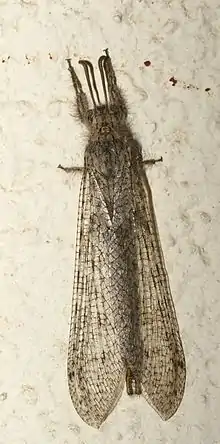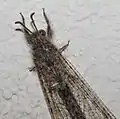Centroclisis
Centroclisis is a genus of antlions (Myrmeleontidae) with about 56 species occurring in Africa and Asia.[2] They are known as bark antlions - during the day they rest on the bark of trees, with their wings flattened.[3] At night they may be attracted to lights.
| Centroclisis | |
|---|---|
 | |
| Centroclisis maligna | |
| Scientific classification | |
| Domain: | Eukaryota |
| Kingdom: | Animalia |
| Phylum: | Arthropoda |
| Class: | Insecta |
| Order: | Neuroptera |
| Family: | Myrmeleontidae |
| Subfamily: | Acanthaclisinae |
| Tribe: | Acanthaclisini |
| Genus: | Centroclisis Navas, 1909 |
Species
Centroclisis maligna
Widespread and fairly common in the drier western parts of southern Africa. It can distinguished from other Centroclisis species by its reddish colour. The larvae are large and robust; they live in sandy soils, but do not make pitfall traps.[4]
Centroclisis vitanda
This species is endemic to South Africa; it is known only from the Eastern Cape, Northern Cape and Free State provinces. The male has long ectoprocts. During the day it normally rests, well camouflaged, on bark. Its immature stages are poorly known, but the larvae probably live in sandy soils.[5]
 Male Centroclisis vitanda
Male Centroclisis vitanda
References
- "Genus Centroclisis (Navas, 1909), Taxonomy". insectoid.info. Archived from the original on 15 April 2017. Retrieved 14 April 2017.
- Picker, Mike; Griffiths, Charles; Weaving, Alan (2004). Field guide to insects of South Africa (2 ed.). Cape Town: Struik. ISBN 9781770070615.
- Mansell, Mervyn. "LacewingMAP record 10181". vmus.adu.org.za. Retrieved 14 April 2017.
- Mansell, Mervyn. "LacewingMAP record 10184". vmus.adu.org.za. Retrieved 14 April 2017.

